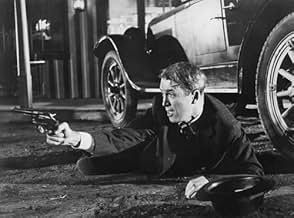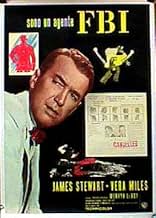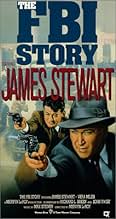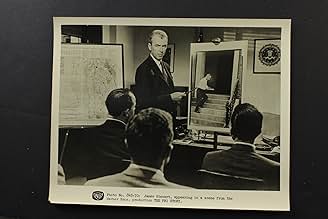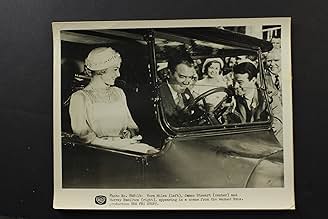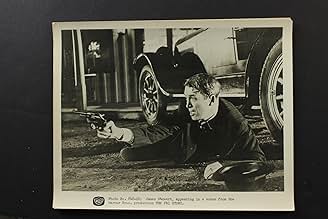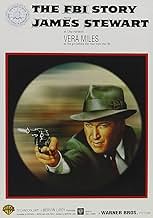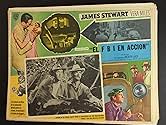IMDb-BEWERTUNG
6,5/10
4090
IHRE BEWERTUNG
Ein engagierter FBI-Agent erinnert sich an die Kämpfe der Behörde gegen den Ku-Klux-Klan, das organisierte Verbrechen und kommunistische Spione.Ein engagierter FBI-Agent erinnert sich an die Kämpfe der Behörde gegen den Ku-Klux-Klan, das organisierte Verbrechen und kommunistische Spione.Ein engagierter FBI-Agent erinnert sich an die Kämpfe der Behörde gegen den Ku-Klux-Klan, das organisierte Verbrechen und kommunistische Spione.
- Regie
- Drehbuch
- Hauptbesetzung
- Auszeichnungen
- 1 Nominierung insgesamt
Ken Mayer
- Casket Salesman
- (as Kenneth Mayer)
Victor Adamson
- Train Passenger
- (Nicht genannt)
Luana Anders
- Mrs. Graham
- (Nicht genannt)
Empfohlene Bewertungen
This starts almost like a high school educational film about the FBI. The narration is actually veteran agent Chip Hardesty (James Stewart) doing a lecture. He recounts the story of the FBI starting from its early haphazard days in 1924. He marries pretty librarian Lucy Ann Ballard (Vera Miles). Over the years, he investigates the Ku Klux Klan, the Osage Indian murders, various gangsters, Nazis in Brazil, and communist spies.
This is a sympathetic look at the FBI approved by Hoover. The opening is like a school educational film which is par for the course. It's an old fashion take on the federal police force. It definitely doesn't indulge in any controversies against the FBI. There may violence by the KKK but there is no mentions of lynching. They round up enemy aliens during WWII but they don't talk about the thousands of innocent citizens in internment camps. It's also episodic in nature. The plot doesn't flow as much as it continues on and on. This is definitely a movie where Hollywood submits to authority.
This is a sympathetic look at the FBI approved by Hoover. The opening is like a school educational film which is par for the course. It's an old fashion take on the federal police force. It definitely doesn't indulge in any controversies against the FBI. There may violence by the KKK but there is no mentions of lynching. They round up enemy aliens during WWII but they don't talk about the thousands of innocent citizens in internment camps. It's also episodic in nature. The plot doesn't flow as much as it continues on and on. This is definitely a movie where Hollywood submits to authority.
"The FBI Story" tries to tell the story of the evolution of the FBI over 35 years, through the eyes of a veteran agent, Chip Hardesty (James Stewart). It spins off into several segments covering Hardesty's career. There's a segment on the Klu Klux Klan (with nary an African American in sight), one showing the cheating of native Americans out of their oil leases in Texas and several brief run-ins with the well known gangsters of the 1930s.
Inrerspersed with these episodes are home life interludes where Stewart's character turns into George Bailey ("Its a Wonderful Life" (1946)). He meets and marries Lucy (Vera Miles) and we follow their lives through the birth of three children, a miscarriage, a separation and a war time tragedy.
Told in a documentary style, this film, in my opinion is far too long at 149 minutes. The action sequences, such as they are, are brief and with no character development of the gangsters. They are simply confronted by the FBI and either arrested or gunned down. The Hardesty character is hardly involved in these segments and he does not confront any of the gangsters directly.
The at home sequences while well played, look like something out of "Father Knows Best", the popular TV series of the day. Another thing I found unusual was the fact that Stewart and Miles basically carry the whole film. Other characters appear briefly then either get killed off or disappear altogether. While Stewart and Miles do their best, they hardly seem to have aged 35 years over the course of the story. And there are no name actors to speak of in the supporting cast. Murray Hamilton, Larry Pennell and Nick Adams do appear briefly, but were not that well known in 1959.
James Cagney's "G-Men" (1935) covered the FBI's early years much better.
Inrerspersed with these episodes are home life interludes where Stewart's character turns into George Bailey ("Its a Wonderful Life" (1946)). He meets and marries Lucy (Vera Miles) and we follow their lives through the birth of three children, a miscarriage, a separation and a war time tragedy.
Told in a documentary style, this film, in my opinion is far too long at 149 minutes. The action sequences, such as they are, are brief and with no character development of the gangsters. They are simply confronted by the FBI and either arrested or gunned down. The Hardesty character is hardly involved in these segments and he does not confront any of the gangsters directly.
The at home sequences while well played, look like something out of "Father Knows Best", the popular TV series of the day. Another thing I found unusual was the fact that Stewart and Miles basically carry the whole film. Other characters appear briefly then either get killed off or disappear altogether. While Stewart and Miles do their best, they hardly seem to have aged 35 years over the course of the story. And there are no name actors to speak of in the supporting cast. Murray Hamilton, Larry Pennell and Nick Adams do appear briefly, but were not that well known in 1959.
James Cagney's "G-Men" (1935) covered the FBI's early years much better.
An entertaining tribute to American law enforcement's most legendary force falls victim to Hollywood hokum, unrealistic dialogue, and choking piety regarding everything about the Federal Bureau Of Investigation, especially its founder, J. Edgar Hoover.
While Hoover is often referenced, sometimes heard, and even briefly seen at his desk, Buddha-like, the focus here is on fictional FBI agent Chip Hardesty (James Stewart), who dedicates himself to serving the bureau through decades of crime-fighting heroics. Whether ambushing John Dillinger or rounding up the Ku Klux Klan, Hardesty provides a case example of the heroism from which the FBI was made.
The final words of the film, superimposed on the screen over triumphant fanfare, establish what "The FBI Story" is all about: "Our sincere thanks to the FBI and J. Edgar Hoover not only for their guidance and active participation in the making of this motion picture but also for making this world of ours a safer place in which to live..."
If they had saved this boilerplate for the end, "The FBI Story" might have had a chance. Stewart was one of the greats, and in Vera Miles as the love interest he enjoys steady support. Few color films from the 1950s are this crisp- and dynamic-looking. Director Mervyn LeRoy was famously good at his job, and manages some stellar framing work with an eye for period detail in the episodic sequences showing Hardesty on the job at various stages of the FBI's existence.
But the accent of this film is not on delivering quality entertainment but burnishing Director Hoover's ego. At every turn, we get our noses rubbed into how brilliant an organization he set up, to the point where suspense gets crushed before it has a chance to develop.
An opening sequence features Nick Adams as a young man named Graham who kills his mother and 48 other people on board a plane by putting a bomb inside her luggage. Immediately we see FBI agents questioning him and searching his house until he cracks and confesses, even yelling at the end to send his mail to hell.
"Jack Graham's only mistake was that he was absent-minded," Stewart tells us in a voice-over. "He forgot about the broad research powers of the FBI."
Elsewhere we get lengthy descriptions of what these powers are, and even footage of people typing or staring into microscopes at FBI headquarters.
The dialogue in this film is much too purple, as if competing for your attention with Max Steiner's bombastic score. There are some howlers other reviewers here pointed out; my favorite is when Miles gets cross when she finds out her husband is going out armed to take on some public enemies. He tells her to take it easy.
"You take it easy, Chip! I don't look good in black."
Murray Hamilton has his own over-the-top moments as Chip's FBI buddy, all charged up with Hoover in charge. "I never wanna cool down," he says. No worries; a breathless script by Richard L. Breen and John Twist won't let him until it's time to stop and smell the lilacs.
There's one solid sequence where Hardesty investigates the murders of Osage Indians in Oklahoma. That works as a crime story with some mystery and humor to it, not to mention a satisfying wrapper.
The rest of the time, it's like some jacked-up medley of J. Edgar's greatest hits, like taking down bank robbers and a Soviet spy ring. Much padding involves Hardesty's family affairs, like his search for missing tissue paper or a crisis involving a shattered dish of pickles. Even when the script tries to drum up a crisis between Hardesty and his wife, the result is unconvincing and much-too-easily resolved.
That goes for most everything else involving "The FBI Story," rich in visual style but cheap in too many other departments, including the kind of patriotism too often used as the refuge of scoundrels. I do admire J. Edgar Hoover in some areas, but when it came to making movies, he should have stayed in the closet.
While Hoover is often referenced, sometimes heard, and even briefly seen at his desk, Buddha-like, the focus here is on fictional FBI agent Chip Hardesty (James Stewart), who dedicates himself to serving the bureau through decades of crime-fighting heroics. Whether ambushing John Dillinger or rounding up the Ku Klux Klan, Hardesty provides a case example of the heroism from which the FBI was made.
The final words of the film, superimposed on the screen over triumphant fanfare, establish what "The FBI Story" is all about: "Our sincere thanks to the FBI and J. Edgar Hoover not only for their guidance and active participation in the making of this motion picture but also for making this world of ours a safer place in which to live..."
If they had saved this boilerplate for the end, "The FBI Story" might have had a chance. Stewart was one of the greats, and in Vera Miles as the love interest he enjoys steady support. Few color films from the 1950s are this crisp- and dynamic-looking. Director Mervyn LeRoy was famously good at his job, and manages some stellar framing work with an eye for period detail in the episodic sequences showing Hardesty on the job at various stages of the FBI's existence.
But the accent of this film is not on delivering quality entertainment but burnishing Director Hoover's ego. At every turn, we get our noses rubbed into how brilliant an organization he set up, to the point where suspense gets crushed before it has a chance to develop.
An opening sequence features Nick Adams as a young man named Graham who kills his mother and 48 other people on board a plane by putting a bomb inside her luggage. Immediately we see FBI agents questioning him and searching his house until he cracks and confesses, even yelling at the end to send his mail to hell.
"Jack Graham's only mistake was that he was absent-minded," Stewart tells us in a voice-over. "He forgot about the broad research powers of the FBI."
Elsewhere we get lengthy descriptions of what these powers are, and even footage of people typing or staring into microscopes at FBI headquarters.
The dialogue in this film is much too purple, as if competing for your attention with Max Steiner's bombastic score. There are some howlers other reviewers here pointed out; my favorite is when Miles gets cross when she finds out her husband is going out armed to take on some public enemies. He tells her to take it easy.
"You take it easy, Chip! I don't look good in black."
Murray Hamilton has his own over-the-top moments as Chip's FBI buddy, all charged up with Hoover in charge. "I never wanna cool down," he says. No worries; a breathless script by Richard L. Breen and John Twist won't let him until it's time to stop and smell the lilacs.
There's one solid sequence where Hardesty investigates the murders of Osage Indians in Oklahoma. That works as a crime story with some mystery and humor to it, not to mention a satisfying wrapper.
The rest of the time, it's like some jacked-up medley of J. Edgar's greatest hits, like taking down bank robbers and a Soviet spy ring. Much padding involves Hardesty's family affairs, like his search for missing tissue paper or a crisis involving a shattered dish of pickles. Even when the script tries to drum up a crisis between Hardesty and his wife, the result is unconvincing and much-too-easily resolved.
That goes for most everything else involving "The FBI Story," rich in visual style but cheap in too many other departments, including the kind of patriotism too often used as the refuge of scoundrels. I do admire J. Edgar Hoover in some areas, but when it came to making movies, he should have stayed in the closet.
In the tradition of G-Men, The House On 92nd Street, The Street With No Name, now comes The FBI Story one of those carefully supervised films that showed the Federal Bureau of Investigation in the best possible light. While it's 48 year director J. Edgar Hoover was alive, it would be showed in no other kind of light.
The book by Don Whitehead that this film is based on is a straight forward history of the bureau from it's founding in 1907 until roughly the time the film The FBI Story came out. It's important sometimes to remember there WAS an FBI before J. Edgar Hoover headed it. Some of that time is covered in the film as well.
But Warner Brothers was not making a documentary so to give the FBI flesh and blood the fictional character of John 'Chip' Hardesty was created. Hardesty as played by James Stewart is a career FBI man who graduated law school and rather than go in practice took a job with the bureau in the early twenties.
In real life the Bureau was headed by William J. Burns of the Burns Private Detective Agency. It was in fact a grossly political operation then as is showed in the film. Burns was on the periphery of the scandals of the Harding administration. When Hoover was appointed in 1924 to bring professional law enforcement techniques and rigorous standards of competence in, he did just that.
Through the Hardesty family which is Stewart and wife Vera Miles we see the history of the FBI unfold. In addition we see a lot of their personal family history which is completely integrated into the FBI's story itself. Stewart and Miles are most assuredly an all American couple. We follow the FBI through some of the cases Stewart is involved with, arresting Ku Klux Klan members, a plot to murder oil rich Indians, bringing down the notorious criminals of the thirties, their involvement with apprehending Nazi sympathizers in World War II and against Communist espionage in the Cold War.
There is a kind of prologue portion where Stewart tells a class at the FBI Academy before going into the history of the bureau as it intertwines with his own. That involves a bomb placed on an airline by a son who purchased a lot of life insurance on his mother before the flight. Nick Adams will give you the creeps as the perpetrator and the story is sadly relevant today.
Of course if The FBI Story were written and produced today it would reflect something different and not so all American. Still the FBI does have a story to tell and it is by no means a negative one.
The FBI Story is not one of Jimmy Stewart's best films, but it's the first one I ever saw with my favorite actor in it so it has a special fondness for me. If the whole FBI were made up Jimmy Stewarts, I'd feel a lot better about it. There's also a good performance by Murray Hamilton as his friend and fellow agent who is killed in a shootout with Baby Face Nelson.
Vera Miles didn't just marry Stewart, she in fact married the FBI as the film demonstrates. It's dated mostly, but still has a good and interesting story to tell.
The book by Don Whitehead that this film is based on is a straight forward history of the bureau from it's founding in 1907 until roughly the time the film The FBI Story came out. It's important sometimes to remember there WAS an FBI before J. Edgar Hoover headed it. Some of that time is covered in the film as well.
But Warner Brothers was not making a documentary so to give the FBI flesh and blood the fictional character of John 'Chip' Hardesty was created. Hardesty as played by James Stewart is a career FBI man who graduated law school and rather than go in practice took a job with the bureau in the early twenties.
In real life the Bureau was headed by William J. Burns of the Burns Private Detective Agency. It was in fact a grossly political operation then as is showed in the film. Burns was on the periphery of the scandals of the Harding administration. When Hoover was appointed in 1924 to bring professional law enforcement techniques and rigorous standards of competence in, he did just that.
Through the Hardesty family which is Stewart and wife Vera Miles we see the history of the FBI unfold. In addition we see a lot of their personal family history which is completely integrated into the FBI's story itself. Stewart and Miles are most assuredly an all American couple. We follow the FBI through some of the cases Stewart is involved with, arresting Ku Klux Klan members, a plot to murder oil rich Indians, bringing down the notorious criminals of the thirties, their involvement with apprehending Nazi sympathizers in World War II and against Communist espionage in the Cold War.
There is a kind of prologue portion where Stewart tells a class at the FBI Academy before going into the history of the bureau as it intertwines with his own. That involves a bomb placed on an airline by a son who purchased a lot of life insurance on his mother before the flight. Nick Adams will give you the creeps as the perpetrator and the story is sadly relevant today.
Of course if The FBI Story were written and produced today it would reflect something different and not so all American. Still the FBI does have a story to tell and it is by no means a negative one.
The FBI Story is not one of Jimmy Stewart's best films, but it's the first one I ever saw with my favorite actor in it so it has a special fondness for me. If the whole FBI were made up Jimmy Stewarts, I'd feel a lot better about it. There's also a good performance by Murray Hamilton as his friend and fellow agent who is killed in a shootout with Baby Face Nelson.
Vera Miles didn't just marry Stewart, she in fact married the FBI as the film demonstrates. It's dated mostly, but still has a good and interesting story to tell.
This is a film that on the surface would seem to be all about J.Edgar Hoover giving himself a a big pat on the back for fighting Klansmen,going after Indian killers, hunting the famous gangsters of the 1930's, fighting Nazi's in the US and South America during world war 2 and Commies in New York during the early 1950's. Of course in 1959 we did not know about Mr. Hoover's obsession for keeping secret files on honest Americans, bugging people like the Rev. Martin Luther King, Jr, but worst of all,his secret love affair with his deputy director,Clyde Tolson( If you want to know more about that subject, I suggest seeing the film Citizen Cohn). Hoover aside, This story of a life in the FBI as told by Jimmy Stewart makes for a decent, but dated film. Vera Miles as his devoted wife is also good. But Jimmy is the movie. As much as Hoover controlled production and always made sure the FBI was seen without fault, Jimmy Stewart gave the film a human side,quite an achievement considering Hoover was always looking over his shoulder. The background score is also pleasant. I have read recent online articles suggesting that this is a forgotten film. Jimmy Stewart was one of the greatest film stars of all time and none of his films should be forgotten. TCM was the last network to show it a long time ago and I hope they show it again.
Wusstest du schon
- WissenswertesTwo FBI agents were on the set at all times.
- PatzerJennie forgets her speech at a mid-term Honor Society event. When her father comforts her in the family car a few moments later, the cherry blossoms are in bloom; this usually occurs in early April in Washington (DC). However, after they leave the car with the radio still on, a news bulletin breaks in, announcing the attack on Pearl Harbor, which took place on December 7, 1941. No cherry blossoms would have been in bloom then, nor would the weather have been mild enough as depicted in the accompanying scenes.
- Zitate
[first lines]
John Michael Hardesty: [narrating] Webster's International Dictionary defines murder as the unlawful taking of human life by another human being. On a November evening in 1955, the definition became obsolete. A mass murder was being planned.
- VerbindungenEdited from Es wird immer wieder Tag (1954)
Top-Auswahl
Melde dich zum Bewerten an und greife auf die Watchlist für personalisierte Empfehlungen zu.
- How long is The FBI Story?Powered by Alexa
Details
- Erscheinungsdatum
- Herkunftsland
- Sprache
- Auch bekannt als
- The FBI Story
- Drehorte
- Produktionsfirmen
- Weitere beteiligte Unternehmen bei IMDbPro anzeigen
- Laufzeit
- 2 Std. 29 Min.(149 min)
- Seitenverhältnis
- 1.66 : 1
Zu dieser Seite beitragen
Bearbeitung vorschlagen oder fehlenden Inhalt hinzufügen


